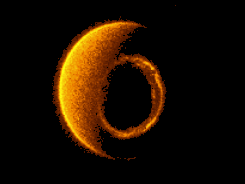Cameras aboard satellites can look down at the aurora and snap its
instantaneous picture at some given moment. What they see is
a roughly circular strip, centered a little nightward of the magnetic pole,
known as the auroral oval. During large magnetic storms the oval grows in size and may even reach the population centers of Europe and America, giving people there a rare opportunity to watch auroras from their own backyards.
The narrow auroral oval gives the instantaneous shape of the aurora. The "auroral zone" plotted by Loomis and by Fritz is much more smeared out, because
it is the long term statistical average of many aurora observations. During some of them the oval is large, during others it is small, and it can also be displaced towards midnight and in other ways, all of which add up to produce a broad band.
Inside the Oval -- the Polar Rain
Field lines starting from points of the dark region inside the auroral oval, which includes the magnetic pole, extend to even greater distances. Early researchers, who believed auroral
electrons came from the Sun (see history) could not understand why the aurora was absent from the vicinity of the
magnetic pole itself. From satellite data we now know that field lines inside
the oval extend to the "tail lobes," the twin bundles of field lines that extend
down the Earth's magnetic tail (blue lines in the figure on top). Ultimately they probably lead into the solar wind, somewhere far on the nightside of the Earth. But the wind there is flowing rapidly away from Earth and its ions are not likely to reverse their direction and head upstream, back towards the Earth. Hence one expects very little plasma to come from that direction.
Yet something does flow earthwards on those field lines, a thin "polar rain" of fast electrons, with energies around 500 electron volts (ev). Solar wind protons have about 1000 ev each, but the electrons which move along with them, being about 2000 times lighter, also have a much smaller average energy. Electrons of 500 ev are a completely different population, easily able to outrace the solar wind and follow field lines in any direction. They are too few to produce a visible aurora, but instruments aboard satellites readily observe them. They provide the best evidence that the tail lobes are indeed connected to the solar wind.
All magnetic field lines have a direction, which is why they are labeled by arrows--out of the southern polar cap, and into the northern one. Similarly, interplanetary field lines also have their directions. For about half the time, typically a week at a stretch, they may point away from the Sun, and the rest of the time, for comparable periods, they point towards it (in addition they are twisted by the Sun's rotation and by other factors).
In 1976 it was discovered that when the interplanetary field lines pointed
away from the Sun, the polar rain was much more intense in the northern cap then in the southern one, while when they pointed towards the Sun, the southern cap received the bigger share. Clearly, those electrons must have come from the Sun, and favored the pole with the direct sunward connection. It was also evident that the interplanetary field lines were somehow linked through the tail
lobes to the appropriate polar caps, although how and where that connection is made is still not known for sure.


